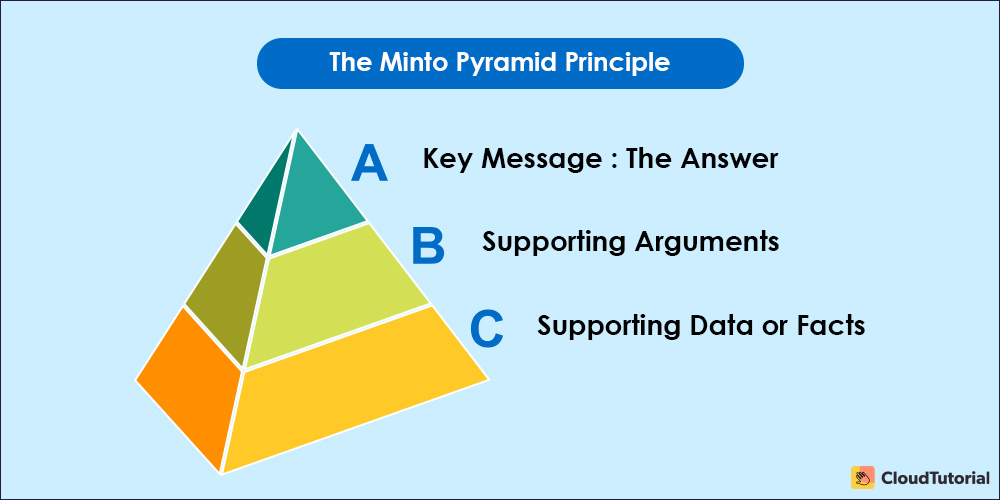Pyramid Principle

In the realm of business, effective communication and problem-solving are paramount. The Pyramid Principle, popularized by Barbara Minto in the late 20th century, offers a structured approach to both. This methodology, rooted in logic and clarity, has become a cornerstone of management consulting firms and is widely adopted across various industries. Understanding and mastering the Pyramid Principle can significantly enhance one’s ability to convey ideas cogently, solve complex problems systematically, and ultimately drive success in professional endeavors.
Understanding the Pyramid Principle:
At its core, the Pyramid Principle advocates for structuring communication in a way that prioritizes clarity and logical flow. The premise is simple yet profound: start with a concise main idea, supported by a few key points, which are further substantiated by details arranged in a hierarchical manner. This structure mirrors the shape of a pyramid, with the main idea at the apex and supporting information forming the base.
The Pyramid Structure:
The Pyramid Principle’s structure can be visualized as follows:
- Main Idea: This is the central thesis or conclusion that the communicator wants to convey. It should be succinct, clear, and ideally placed at the beginning of the communication to provide a roadmap for the audience.
- Key Points: These are the primary supporting arguments that buttress the main idea. Each key point should logically flow from the main idea and serve to reinforce it.
- Supporting Details: These constitute the foundation of the pyramid, providing evidence, examples, data, or rationale that validate the key points. Details should be organized hierarchically, with broader concepts preceding specific instances.
Benefits of the Pyramid Principle:
- Clarity: By distilling complex ideas into a hierarchical structure, the Pyramid Principle facilitates clarity and comprehension. It enables communicators to convey their message concisely, reducing the risk of misinterpretation or confusion.
- Logical Flow: The structured approach of the Pyramid Principle ensures that ideas are presented in a logical sequence, making it easier for the audience to follow the argumentation process. This logical flow enhances persuasiveness and credibility.
- Efficiency: In professional settings where time is often a scarce resource, the Pyramid Principle enables efficient communication. By focusing on the main idea and key points, communicators can convey essential information succinctly, saving time for both the presenter and the audience.
- Problem-Solving: Beyond communication, the Pyramid Principle is a powerful tool for problem-solving. By breaking down complex issues into manageable components, individuals can analyze problems systematically and develop coherent solutions.
Application in Business:
The Pyramid Principle finds widespread application in various business contexts:
- Presentations: Whether pitching a new idea, delivering a project update, or making a sales pitch, structuring presentations according to the Pyramid Principle enhances effectiveness. Beginning with a clear main idea and supporting it with key points and relevant details captivates the audience and facilitates understanding.
- Reports and Documents: From business reports to strategic plans, written communication in organizations benefits from the Pyramid Principle. By organizing information hierarchically, reports become more accessible, actionable, and persuasive.
- Problem-Solving Workshops: In collaborative problem-solving settings, such as workshops or brainstorming sessions, applying the Pyramid Principle fosters clarity and focus. It helps participants articulate their ideas coherently and ensures that discussions remain structured and productive.
- Strategic Decision-Making: When faced with complex strategic decisions, leaders can use the Pyramid Principle to dissect issues, identify critical factors, and weigh alternative courses of action. This structured approach minimizes cognitive overload and facilitates informed decision-making.
Mastering the Pyramid Principle:
While understanding the Pyramid Principle is relatively straightforward, mastering it requires practice and refinement:
- Clarity of Thought: Before communicating any idea, clarity of thought is paramount. Take time to distill complex concepts into clear, concise main ideas and supporting points.
- Audience Understanding: Tailor your communication to the needs and knowledge level of your audience. Anticipate their questions and concerns, and address them proactively within the Pyramid structure.
- Edit and Refine: Effective communication often requires iteration. Review your communication drafts critically, eliminating extraneous details and refining the logical flow until the structure is tight and coherent.
- Practice Active Listening: In addition to honing your communication skills, practice active listening to understand others’ perspectives and respond thoughtfully. Applying the Pyramid Principle to both speaking and listening enhances overall communication effectiveness.
Conclusion:
The Pyramid Principle stands as a timeless framework for effective communication and problem-solving in the business world. By organizing ideas in a hierarchical structure that prioritizes clarity and logic, communicators can convey their message persuasively and navigate complex challenges with confidence. Mastery of the Pyramid Principle is not merely a skill; it is a mindset that fosters clarity of thought, efficiency, and strategic acumen. As businesses continue to evolve in an increasingly complex and fast-paced environment, embracing the Pyramid Principle offers a competitive advantage in driving success and achieving impactful outcomes.





